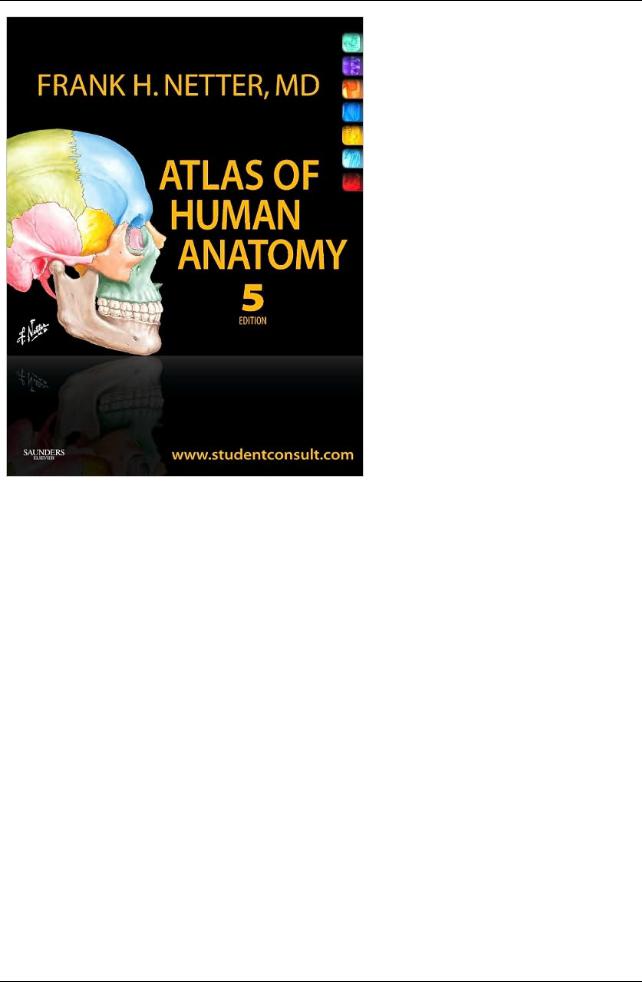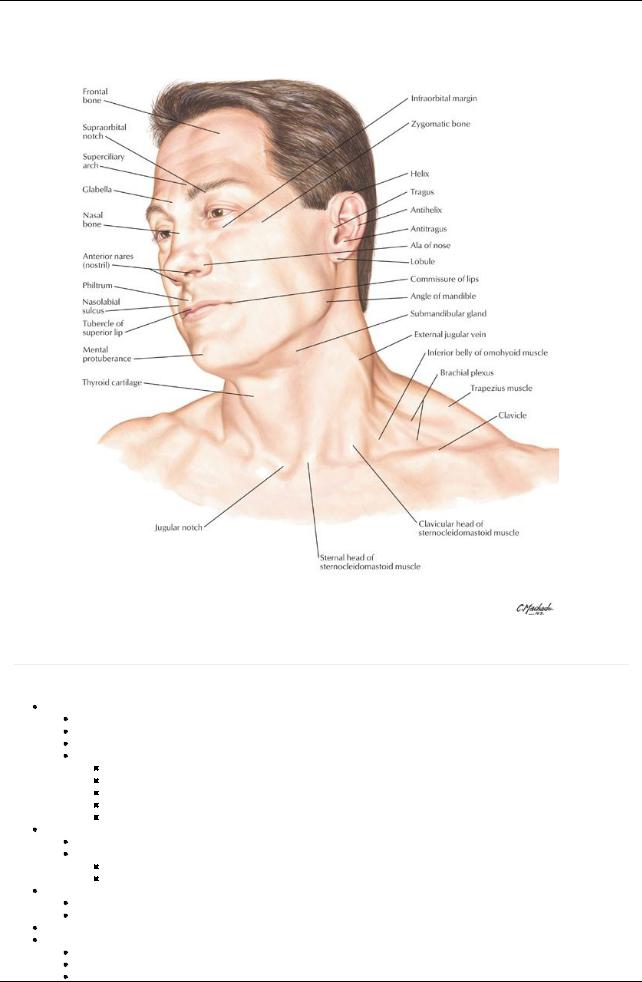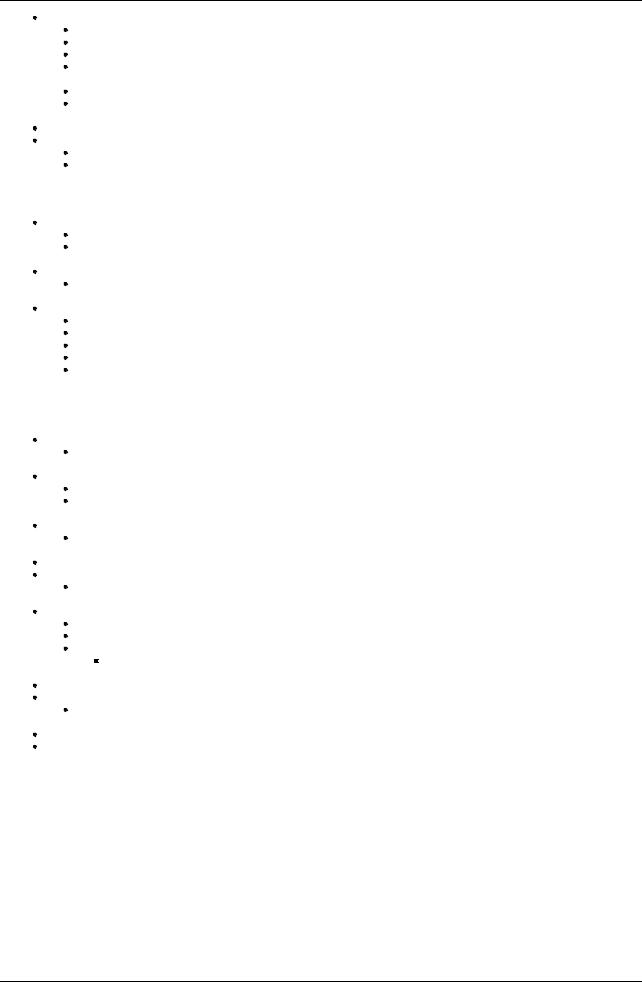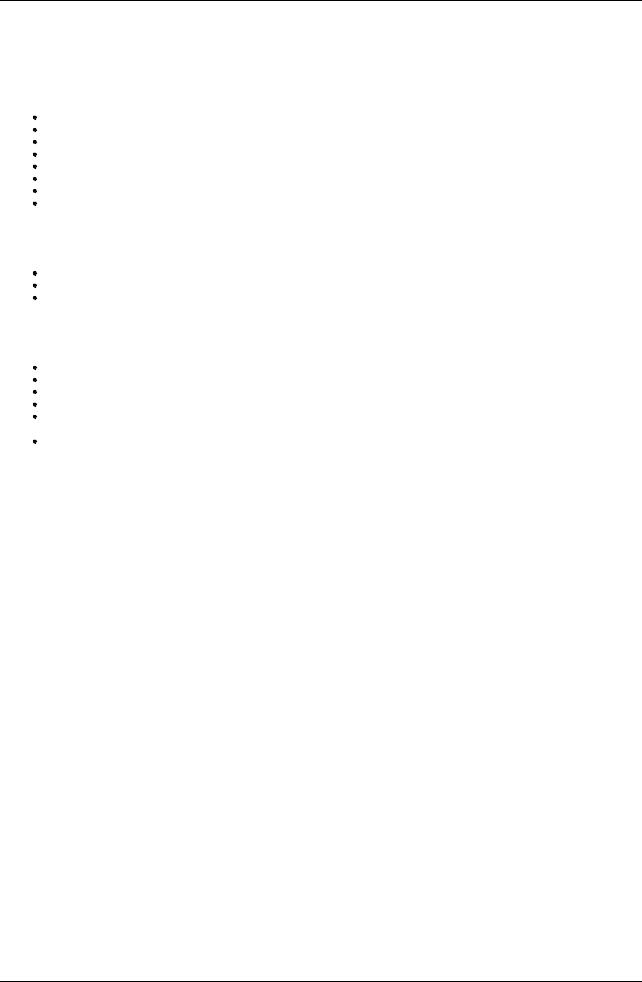
- •1. Topographic Surface Anatomy
- •Guide
- •Facts & Hints
- •Guide
- •Facts & Hints
- •3. Superficial Face
- •Guide
- •Facts & Hints
- •4. Neck
- •Guide
- •Facts & Hints
- •5. Nasal Region
- •Guide
- •Facts & Hints
- •6. Oral Region
- •Guide
- •Facts & Hints
- •7. Pharynx
- •Guide
- •Facts & Hints
- •Guide
- •Facts & Hints
- •Guide
- •Facts & Hints
- •Guide
- •Facts & Hints
- •Guide
- •Facts & Hints
- •Guide
- •Facts & Hints
- •13. Cerebral Vasculature
- •Guide
- •Facts & Hints
- •14. Topographic Anatomy
- •Guide
- •Facts & Hints
- •Guide
- •Facts & Hints
- •16. Spinal Cord
- •Guide
- •Facts & Hints
- •Guide
- •Facts & Hints
- •Thorax
- •18. Topographic Anatomy
- •Guides
- •Facts & Hints
- •19. Mammary Gland
- •Guides
- •Facts & Hints
- •20. Body Wall
- •Guides
- •Facts & Hints
- •21. Lungs
- •Guides
- •Facts & Hints
- •22. Heart
- •Guides
- •Facts & Hints
- •23. Mediastinum
- •Guides
- •Facts & Hints
- •Abdomen
- •24. Topographic Anatomy
- •Guide
- •Facts & Hints
- •25. Body Wall
- •Guide
- •Facts & Hints
- •26. Peritoneal Cavity
- •Guide
- •Facts & Hints
- •27. Viscera (Gut)
- •Guide
- •Facts & Hints
- •28. Viscera (Accessory Organs)
- •Guide
- •Facts & Hints
- •29. Visceral Vasculature
- •Guide
- •Facts & Hints
- •30. Innervation
- •Guide
- •Facts & Hints
- •Guide
- •Facts & Hints
- •32. Topographic Anatomy
- •Guide
- •Facts & Hints
- •Guide
- •Facts & Hints
- •Guide
- •Facts & Hints
- •35. Urinary Bladder
- •Guide
- •Facts & Hints
- •Guide
- •Facts & Hints
- •Guide
- •Facts & Hints
- •Guide
- •Facts & Hints
- •39. Testis, Epididymis & Ductus Deferens
- •Guide
- •Facts & Hints
- •40. Rectum
- •Guide
- •Facts & Hints
- •41. Vasculature
- •Guide
- •Facts & Hints
- •42. Innervation
- •Guide
- •Facts & Hints
- •Upper Limb
- •43. Topographic Anatomy
- •Guide
- •Facts & Hints
- •Guide
- •Facts & Hints
- •Guide
- •Facts & Hints
- •Guide
- •Facts & Hints
- •Guide
- •Facts & Hints
- •48. Neurovasculature
- •Guide
- •Facts & Hints
- •Lower Limb
- •49. Topographic Anatomy
- •Guide
- •Facts & Hints
- •Guide
- •Facts & Hints
- •51. Knee
- •Guide
- •Facts & Hints
- •Guide
- •Facts & Hints
- •Guide
- •Facts & Hints
- •54. Neurovasculature
- •Guide
- •Facts & Hints

1 / 425

Head and Neck
page 1
1 Topographic Surface Anatomy
STUDYAIMS
At the end of your study, you should be able to:
Identifythe keylandmarks in the midline of the neck and their significance
State the structures that are situated at the level of C6
Outline the boundaries of the triangles of the neck
Describe the landmarks for palpation of the main arteries, which can be palpated in the face and neck
Identifyprominent features of the face
2 / 425

GUIDE
Head and Neck: Topographic Anatomy
[Plate 1, Head and Neck]
Key Landmarks Midline of Neck
page 1
page 2
There are a number of landmarks visible on the body's surface that correspond to deeper structures.
Hyoid bone
Lies at level of C3 vertebra
U-shaped bone
Does not articulate with anyother bone
Is suspended bymuscles from
Mandible
Styloid processes of temporal bones
Thyroid cartilage
Manubrium of sternum
Scapulae
Thyroid cartilage
Formed from anterior, midline fusion of two laminar plates = laryngeal prominence (Adam's apple)
Laminae diverge superiorly
Form V-shaped thyroid notch
Lie at the level of C4 vertebra
C4 vertebral level
Bifurcation of common carotid arteryinto external and internal carotid arteries
Site of carotid sinus (baroreceptor) and carotid body(chemoreceptor)
Carotid pulse can be palpated at anterior border sternocleidomastoid (level of C5 vertebra)
Cricoid cartilage
Onlycomplete ring cartilage in respiratorytract
Shaped like signet ring with band anteriorly
Lower border corresponds to level of C6 vertebra
3 / 425

C6 vertebral level
Junction of larynxand trachea
Junction of pharynxand esophagus
Level at which inferior and middle thyroid arteries enter the thyroid gland
Vertebral artery(first branch subclavian artery) enters foramen transversarium of C6 transverse process to ascend to brain through successivelyhigher foramina
Superior bellyof omohyoid muscle crosses carotid sheath
Level of middle cervical sympathetic ganglion
 Carotid arterycan be compressed and palpated against transverse process C6 Isthmus of thyroid gland overlies second and third tracheal cartilages
Carotid arterycan be compressed and palpated against transverse process C6 Isthmus of thyroid gland overlies second and third tracheal cartilages
Jugular (suprasternal) notch
Concave center of superior border of manubrium Between medial ends of clavicles
Other Landmarks in the Neck
Platysma
Thin, broad sheet of muscle within superficial fascia of the neck
Amuscle of facial expression, tensing the skin
 Draws corners of mouth down, as in a grimace, and depresses mandible External jugular vein
Draws corners of mouth down, as in a grimace, and depresses mandible External jugular vein
Deep to platysma, descends from angle to mandible to midpoint of clavicle
 Useful for assessment of venous filling with patient sitting at 45 degrees Sternocleidomastoid (SCM)
Useful for assessment of venous filling with patient sitting at 45 degrees Sternocleidomastoid (SCM)
Keylandmark of neck
Divides neck into anterior and posterior triangles (Section 1-4: Head and Neck - Neck)
Sternal head attaches to manubrium of sternum
Clavicular head attaches to superior middle third of clavicle
Can be seen and palpated when acting unilaterallyto flexand rotate head and neck to one side, so that ear approaches shoulder and chin turns in the opposite direction
Landmarks of the Face
Glabella
Smooth midline prominence on the frontal bone
 Located above the root of the nose, between supraorbital margins Zygomatic arch
Located above the root of the nose, between supraorbital margins Zygomatic arch
Forms prominence of cheek
Can palpate superficial temporal arteryat lateral end
 Prone to fractures in facial trauma Mastoid process
Prone to fractures in facial trauma Mastoid process
Bonyprominence behind external acoustic meatus
 Site of proximal attachment sternocleidomastoid muscle Inion-prominent point of external occipital protuberance at back of head Auricle-part of external ear
Site of proximal attachment sternocleidomastoid muscle Inion-prominent point of external occipital protuberance at back of head Auricle-part of external ear
Skin-covered cartilage, except for lobule
 Features include: pinna; tragus; antitragus and helix External nose
Features include: pinna; tragus; antitragus and helix External nose
Skeleton mainlycartilaginous
Dorsum extends from root to apex
Inferior surface has two openings or nares (nostrils)
Bounded laterallybyalae of nose

 Separated byskin over nasal septum Philtrum-midline infranasal depression of upper lip Masseter muscle
Separated byskin over nasal septum Philtrum-midline infranasal depression of upper lip Masseter muscle
Felt over ramus of mandible when teeth are clenched
 Parotid duct can be palpated at medial border (duct opens over second molar inside cheek) Temporalis muscle can be felt above zygomatic arch when teeth clenched
Parotid duct can be palpated at medial border (duct opens over second molar inside cheek) Temporalis muscle can be felt above zygomatic arch when teeth clenched
Facial arterycan be palpated over lower margin bodyof mandible in line with a point one fingerbreadth lateral to the angle of the mouth
4 / 425

FACTS & HINTS
High-Yield Facts
Clinical Points
Tracheostomy
Transverse incision through skin of neck and anterior wall of trachea
Method for achieving a definitive airway
Transverse incision made through skin, at midpoint between suprasternal notch and thyroid cartilage
Platysma and pretracheal fascia divided
Strap muscles retracted
Thyroid isthmus divided or retracted
Opening made between first and second tracheal rings or through second through fourth tracheal rings
Tracheostomytube inserted
Clinical Points
Needle Cricothyrotomy
Done in extreme emergency
Performed if proximal airwayis obstructed, to temporarilyoxygenate the patient
Large-bore needle inserted into the cricothyroid membrane and connected to an oxygen supply
Clinical Points
Central venous line
Large veins such as the subclavian have relativelyconstant relationships to easilyidentifiable anatomic landmarks Placement of large-bore venous catheter in an emergent situation to deliver high flow of fluid or blood products Used for administration of chemotherapeutic agents, hyperalimentation fluids, and so on
Used for assessing right heart (venous) pressures
Vein located in an area bounded bythe sternal and clavicular attachments of sternocleidomastoid and the clavicle-just deep to middle third of clavicle
Subclavian vein is inferior and anterior to subclavian arteryand separated from it byanterior scalene muscle
5 / 425

2 Bones and Ligaments
STUDYAIMS
At the end of your study, you should be able to:
Describe the anatomic division of the head into a neuroand viscerocranium Describe the function of the neuroand viscerocranium
Outline the bones that form the neurocranium Know the major sutures of the skull
Describe the division of the base of skull into anterior, middle, and posterior cranial fossae and the contents of each List the foramina and keystructures that pass through them
Identifythe prominent features of the mandible
Describe the structure of the temporomandibular joint and the ligaments that stabilize it
6 / 425
